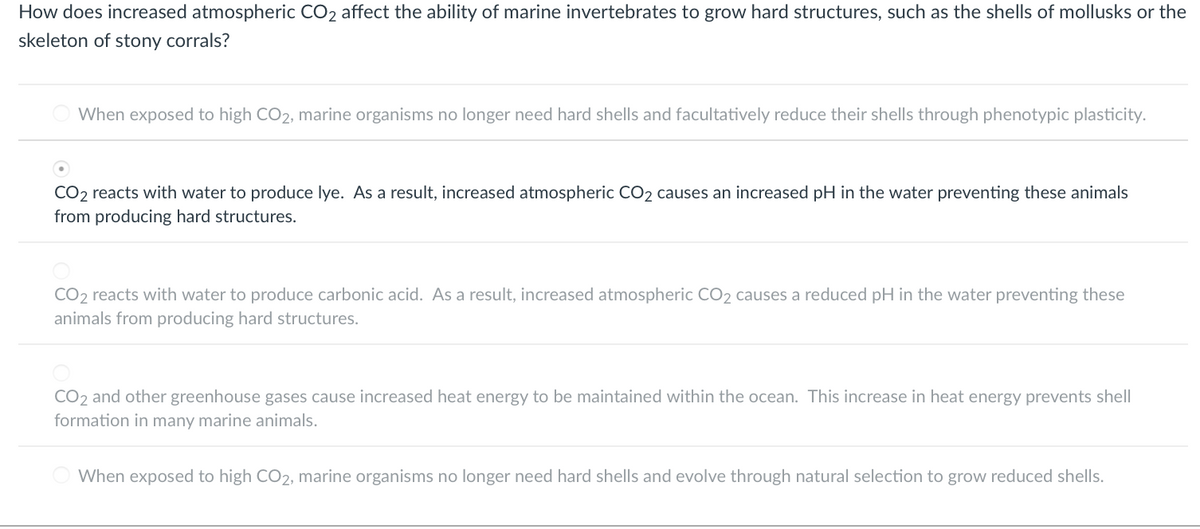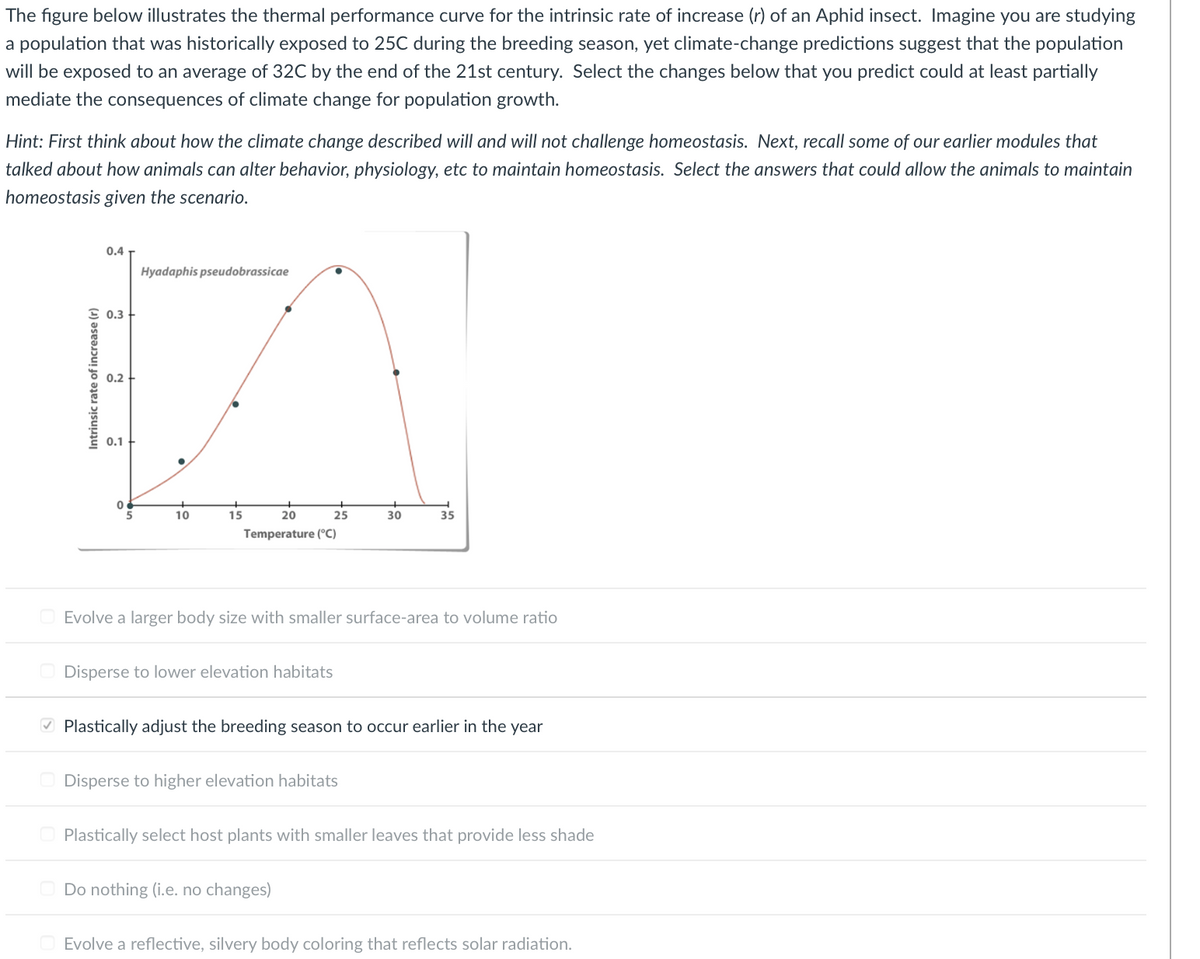How does increased atmospheric CO2 affect the ability of marine invertebrates to grow hard structures, such as the shells of mollusks or the skeleton of stony corrals? When exposed to high CO2, marine organisms no longer need hard shells and facultatively reduce their shells through phenotypic plasticity. CO2 reacts with water to produce lye. As a result, increased atmospheric CO2 causes an increased pH in the water preventing these animals from producing hard structures. CO2 reacts with water to produce carbonic acid. As a result, increased atmospheric CO2 causes a reduced pH in the water preventing these animals from producing hard structures. CO2 and other greenhouse gases cause increased heat energy to be maintained within the ocean. This increase in heat energy prevents shell formation in many marine animals. When exposed to high CO2, marine organisms no longer need hard shells and evolve through natural selection to grow reduced shells.
How does increased atmospheric CO2 affect the ability of marine invertebrates to grow hard structures, such as the shells of mollusks or the skeleton of stony corrals? When exposed to high CO2, marine organisms no longer need hard shells and facultatively reduce their shells through phenotypic plasticity. CO2 reacts with water to produce lye. As a result, increased atmospheric CO2 causes an increased pH in the water preventing these animals from producing hard structures. CO2 reacts with water to produce carbonic acid. As a result, increased atmospheric CO2 causes a reduced pH in the water preventing these animals from producing hard structures. CO2 and other greenhouse gases cause increased heat energy to be maintained within the ocean. This increase in heat energy prevents shell formation in many marine animals. When exposed to high CO2, marine organisms no longer need hard shells and evolve through natural selection to grow reduced shells.
Human Anatomy & Physiology (11th Edition)
11th Edition
ISBN:9780134580999
Author:Elaine N. Marieb, Katja N. Hoehn
Publisher:Elaine N. Marieb, Katja N. Hoehn
Chapter1: The Human Body: An Orientation
Section: Chapter Questions
Problem 1RQ: The correct sequence of levels forming the structural hierarchy is A. (a) organ, organ system,...
Related questions
Question

Transcribed Image Text:How does increased atmospheric CO2 affect the ability of marine invertebrates to grow hard structures, such as the shells of mollusks or the
skeleton of stony corrals?
When exposed to high CO2, marine organisms no longer need hard shells and facultatively reduce their shells through phenotypic plasticity.
CO2 reacts with water to produce lye. As a result, increased atmospheric CO2 causes an increased pH in the water preventing these animals
from producing hard structures.
CO2 reacts with water to produce carbonic acid. As a result, increased atmospheric CO2 causes a reduced pH in the water preventing these
animals from producing hard structures.
CO2 and other greenhouse gases cause increased heat energy to be maintained within the ocean. This increase in heat energy prevents shell
formation in many marine animals.
When exposed to high CO2, marine organisms no longer need hard shells and evolve through natural selection to grow reduced shells.

Transcribed Image Text:The figure below illustrates the thermal performance curve for the intrinsic rate of increase (r) of an Aphid insect. Imagine you are studying
a population that was historically exposed to 25C during the breeding season, yet climate-change predictions suggest that the population
will be exposed to an average of 32C by the end of the 21st century. Select the changes below that you predict could at least partially
mediate the consequences of climate change for population growth.
Hint: First think about how the climate change described will and will not challenge homeostasis. Next, recall some of our earlier modules that
talked about how animals can alter behavior, physiology, etc to maintain homeostasis. Select the answers that could allow the animals to maintain
homeostasis given the scenario.
0.4
Hyadaphis pseudobrassicae
0.3
0.2
0.1
10
15
20
25
30
35
Temperature (°C)
Evolve a larger body size with smaller surface-area to volume ratio
O Disperse to lower elevation habitats
O Plastically adjust the breeding season to occur earlier in the year
O Disperse to higher elevation habitats
Plastically select host plants with smaller leaves that provide less shade
Do nothing (i.e. no changes)
Evolve a reflective, silvery body coloring that reflects solar radiation.
Intrinsic rate of increase (r)
Expert Solution
This question has been solved!
Explore an expertly crafted, step-by-step solution for a thorough understanding of key concepts.
This is a popular solution!
Trending now
This is a popular solution!
Step by step
Solved in 2 steps

Knowledge Booster
Learn more about
Need a deep-dive on the concept behind this application? Look no further. Learn more about this topic, biology and related others by exploring similar questions and additional content below.Recommended textbooks for you

Human Anatomy & Physiology (11th Edition)
Biology
ISBN:
9780134580999
Author:
Elaine N. Marieb, Katja N. Hoehn
Publisher:
PEARSON

Biology 2e
Biology
ISBN:
9781947172517
Author:
Matthew Douglas, Jung Choi, Mary Ann Clark
Publisher:
OpenStax

Anatomy & Physiology
Biology
ISBN:
9781259398629
Author:
McKinley, Michael P., O'loughlin, Valerie Dean, Bidle, Theresa Stouter
Publisher:
Mcgraw Hill Education,

Human Anatomy & Physiology (11th Edition)
Biology
ISBN:
9780134580999
Author:
Elaine N. Marieb, Katja N. Hoehn
Publisher:
PEARSON

Biology 2e
Biology
ISBN:
9781947172517
Author:
Matthew Douglas, Jung Choi, Mary Ann Clark
Publisher:
OpenStax

Anatomy & Physiology
Biology
ISBN:
9781259398629
Author:
McKinley, Michael P., O'loughlin, Valerie Dean, Bidle, Theresa Stouter
Publisher:
Mcgraw Hill Education,

Molecular Biology of the Cell (Sixth Edition)
Biology
ISBN:
9780815344322
Author:
Bruce Alberts, Alexander D. Johnson, Julian Lewis, David Morgan, Martin Raff, Keith Roberts, Peter Walter
Publisher:
W. W. Norton & Company

Laboratory Manual For Human Anatomy & Physiology
Biology
ISBN:
9781260159363
Author:
Martin, Terry R., Prentice-craver, Cynthia
Publisher:
McGraw-Hill Publishing Co.

Inquiry Into Life (16th Edition)
Biology
ISBN:
9781260231700
Author:
Sylvia S. Mader, Michael Windelspecht
Publisher:
McGraw Hill Education